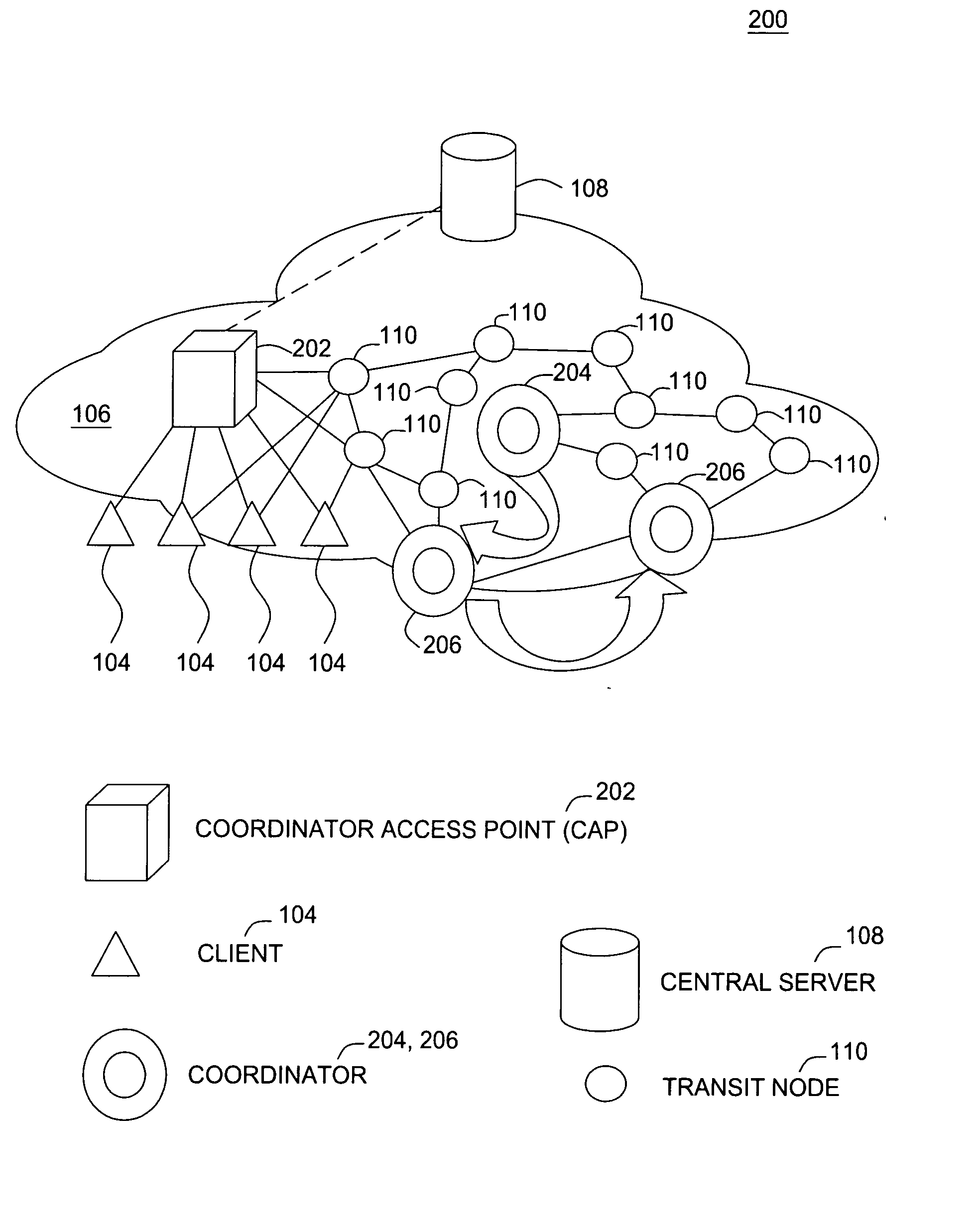Acorn: providing network-level security in P2P overlay architectures
a network-level security and overlay technology, applied in the field of network security, can solve the problems of complicated enforcement of security in a p2p architecture, difficult for a compromised coordinator to cause sustained damage to the network, and disrupt the services provided by these nodes, and achieve the effect of low overhead for moving
- Summary
- Abstract
- Description
- Claims
- Application Information
AI Technical Summary
Problems solved by technology
Method used
Image
Examples
exemplary embodiment 100
[0032]FIG. 1 shows an exemplary embodiment 100 of a static coordinator-based P2P architecture. A MMOG is used as an example to illustrate the coordinator-based P2P architecture. In this coordinator-based P2P gaming topology, a fixed coordinator 102 collects player update information and disseminates it to all the clients 104 (players). Because of the static nature of the coordinator, it is called a static coordinator-based P2P architecture. The network 106 includes a central server 108 and P2P nodes 102, 104, 110. There are three types of P2P nodes: the clients 104 (players), the coordinator 102, and the transit nodes 110.
[0033] The central server 108 is responsible for providing the initial authentication and other accounting services for supporting the game. Players 104 initially connect to the central server 108 to gain access to the game. The central server 108 is also responsible for resynchronizing the game state when a coordinator fails, because there is insufficient time to ...
exemplary embodiment 200
[0042]FIG. 2 shows an exemplary embodiment 200 of a moving coordinator architecture (ACORN). The moving coordinator architecture introduces a new type of node called a coordinator access point (CAP) 202. FIG. 2 also shows a single region with one active coordinator 204 among a set of candidate coordinators 206. One benefit of ACORN is analogous to hitting a moving target. If the target, (i.e., the active coordinator 204 in this case), keeps moving, given that it takes time to aim at the target, it is likely that by the time the attacker aims, the target has already moved. This makes it difficult, if not impossible to attack the active coordinator 204. It is possible that the target will not always have moved in time, due to the associated overhead. However, in general, the result is a reduced Tcheat.
[0043] In both the static coordinator architecture of FIG. 1 and the moving coordinator architecture of FIG. 2, the change of coordinator can be triggered by either a fail or a leave eve...
exemplary embodiment 600
[0051]FIG. 6 shows an exemplary embodiment 600 of the combined effect 606 of the coordinator mapping table (CMT) 602 and the coordinator key table (CKT) 604. One exemplary embodiment of ACORN includes a hash table called a coordinator mapping table (CMT) 602. The CMT 602 has two columns. Each entry in the left column designates a range of ID sequence numbers 608 and the entry in the corresponding right column is a key 610 that the range 608 maps to. The key 610 is used by the standard P2P routing mechanisms to forward messages. Every node 204, 206, 104, 110 (see FIG. 2) is associated with a range of keys 610 the node 202, 204, 206, 104, 110 that is associated with a given key 610 is found by the transit nodes 110. Thus, the mapping of the ID 608 to the key 610 using the CMT 602 is then used by the transit nodes 110 that perform routing to eventually map the key 610 to an IP address 612.
[0052] One exemplary embodiment includes a method of selecting a coordinator 204, 206. The first s...
PUM
 Login to View More
Login to View More Abstract
Description
Claims
Application Information
 Login to View More
Login to View More - R&D
- Intellectual Property
- Life Sciences
- Materials
- Tech Scout
- Unparalleled Data Quality
- Higher Quality Content
- 60% Fewer Hallucinations
Browse by: Latest US Patents, China's latest patents, Technical Efficacy Thesaurus, Application Domain, Technology Topic, Popular Technical Reports.
© 2025 PatSnap. All rights reserved.Legal|Privacy policy|Modern Slavery Act Transparency Statement|Sitemap|About US| Contact US: help@patsnap.com



